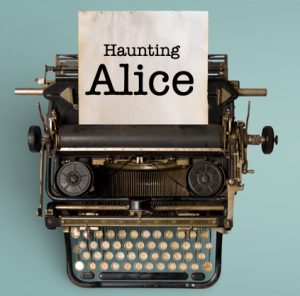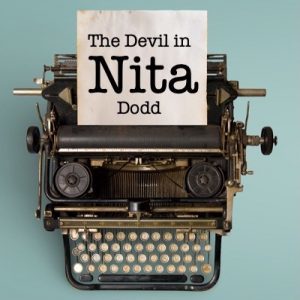Jennifer Crusie's Blog, page 144
October 2, 2019
Working Wednesday, October 2, 2019
 Welp, it’s October. 2019 has escalated quickly. October is probably my second favorite month because of Indian summer and Halloween. You can keep your day-after-Christmas sales; I love the day-after-Halloween sales: cheap skulls and lots of candy. This week I worked on Nita, wrote a proposal for Alice, made an appointment to get my stitches out (after contemplating doing it myself and decided that would be bad although it would have made for an awesome Working Wednesday brag), and made a really great pork chop with cartelized onion and noodles dish. The vet suggested Veronica should be wearing a tight T-shirt so we scored one for three bucks on markdown at Petsmart, and I thought about crocheting for her; then I realized she’d just garbage it up and bought more cheapos on Amazon. If I get my act together, I’ll do a Moment of Dog post so you can see Veronica in her new pink shirt. It says “Miss Understood” on the back. Hey, it was three bucks. There was a hoodie that said “K Bye”, but it was nineteen bucks and I’d already dropped over $800 on her at the vet’s so we went with Miss Understood.
Welp, it’s October. 2019 has escalated quickly. October is probably my second favorite month because of Indian summer and Halloween. You can keep your day-after-Christmas sales; I love the day-after-Halloween sales: cheap skulls and lots of candy. This week I worked on Nita, wrote a proposal for Alice, made an appointment to get my stitches out (after contemplating doing it myself and decided that would be bad although it would have made for an awesome Working Wednesday brag), and made a really great pork chop with cartelized onion and noodles dish. The vet suggested Veronica should be wearing a tight T-shirt so we scored one for three bucks on markdown at Petsmart, and I thought about crocheting for her; then I realized she’d just garbage it up and bought more cheapos on Amazon. If I get my act together, I’ll do a Moment of Dog post so you can see Veronica in her new pink shirt. It says “Miss Understood” on the back. Hey, it was three bucks. There was a hoodie that said “K Bye”, but it was nineteen bucks and I’d already dropped over $800 on her at the vet’s so we went with Miss Understood.
What did you work on this week?
The post Working Wednesday, October 2, 2019 appeared first on Argh Ink.

October 1, 2019
The Alice Proposal
 Here’s your link to the Haunting Alice Proposal. (If you’d rather go looking for it, it’s up at the top under the Works in Progress page; just scroll down til you hit the section on Haunting Alice.)
Here’s your link to the Haunting Alice Proposal. (If you’d rather go looking for it, it’s up at the top under the Works in Progress page; just scroll down til you hit the section on Haunting Alice.)
Most of you have read most of the first thirty-plus pages before, but there’s also the first page of the synopsis, which is the first act/first third of the book. You don’t get the rest because of spoilers. (A full proposal would be the pages, the synopsis of the full book, and a query letter.).
And now back to Nita.
The post The Alice Proposal appeared first on Argh Ink.

September 30, 2019
New Month, New Book, New Proposal, Argh
 Because I must get a proposal done before Nita is finished, I have started on a new book. Yeah, I’m not thrilled about that either; I love the book but balancing two narratives in my head is not a good idea, especially since one is overworked and the other is nascent, but here we are. At least it’ll make a nice change for you all since I’ll be bitching about Alice (aka Haunting Alice) instead of Nita (aka The Devil in Nita Dodd).
Because I must get a proposal done before Nita is finished, I have started on a new book. Yeah, I’m not thrilled about that either; I love the book but balancing two narratives in my head is not a good idea, especially since one is overworked and the other is nascent, but here we are. At least it’ll make a nice change for you all since I’ll be bitching about Alice (aka Haunting Alice) instead of Nita (aka The Devil in Nita Dodd).
So what’s a proposal you ask, and how am I making one for Alice? (You have to ask because I need a blog post.).
A proposal is a quick-and-dirty way of showing an agent or an editor the book you want to write. The agent or editor needs to know three things:
• Can you write, especially can you put character on the page?
• Can you plot?
• Is this book of any interest to her? In particular, can she sell this sucker?
To answer “Can you write?” you send the first thirty or so pages of your book.
To answer “Can you plot?” you send a synopsis of the plot.
To answer “Can I sell this?” you send the pages and the proposal to see if she likes it, and you include a cover letter/query letter that includes a paragraph that sells the book.
I could go into all of that in much more depth, but I’m not going to because what I’m interested in here is taking the raw materials of my very early discovery drafts for Alice and whipping them into a proposal, or at least the first-thirty-pages-and-a-synopsis part. This is a real bitch for me because in general I like to have at least half or more of a discovery draft done before I start trying to nail down a plot. For reasons I will not go into here, I don’t have that luxury this time, this needs to get to New York. So…
The good news is that I have the start of the story and I’m very happy with it. The bad news is that it’s only about 8000 words. The good news is that’s about thirty pages, so once I go through and polish it after I knock out the synopsis, it’ll be Good Enough For A Proposal.
So the synopsis. There’s a pretty easy method for synopses that I use based on the central idea question in concert with the whole act system I talked about last week. The central idea question, courtesy of Michael Hauge, is:
Will the protagonist defeat the antagonist and get the goal?
So the synopsis prep starts like this:
Who’s the protagonist? Alice Archer
Who’s the antagonist? Uh, not sure. Could be the love interest, Ethan. Could be the devious parapsychologist, Ulrich. Could be Alice’s murderous Aunt May. Let me get back to you.
What’s the conflict? Alice is trying to close down Archer House because it’s dangerous. The parapsychologist and May both have good reasons to oppose that. How they’ll do it is another question, but I can hit that later. Alice is also trying to keep her insane life under control, one of the many reasons she became a scientist (lepidopterist), and Ethan the magician/illusionist is not helping with that.
Okay, that’s not bad. If it turns out the story is a romance (probably) then the whole Archer House bit becomes a subplot that tests and advances the romance, and Ethan the Annoyingly Unscientific becomes the main antagonist, but the action kind of plot is much easier to plot than a romance, so I’m going with that for right now.
So based on that central conflict (I’d do a conflict box, but it’s pretty obvious), I can use the five turning points to make a plot.
1. Turn out of stability: Alice is leading a stable life. Boring, so what blows that up and catapults her into conflict, preferably on the first page? For the Archer House plot, it’s finding out that her brother wants to sell the house which Alice still considers dangerous. For the romance plot, it’s meeting Ethan. The first scene is meeting Ethan, the third scene is finding out about the sale. Yeah, this is a romance.
2 (End of Act One). Situation gets worse: The guy who wants to buy the house is already renting it and is holding seance weekends there. Relationship grows closer: Alice and Ethan are appalled (Alice) and fascinated (Ethan) by the whole ghost weekend thing, and keep meeting for coffee to collaborate to figure it out. When Ethan tells her that the parapsychologist is having a big blowout at the house on Halloween, they both head south again to stop him.
3 (End of Act Two): Point of No Return: Alice accidentally sleeps with Ethan (not part of her plan) and then realizes her Aunt May (deceased) is still in the house and she’s not alone; somebody dies.
4 (End of Act Three): Crisis: Alice and Ethan are trapped in the house by a storm with a bunch of loons who signed on for more than they can handle in the Halloween Ghost Weekend (I’ll think of something catchier) and some very aggressive ghosts.
5 (End of Act Four and the book): Alice and Ethan burn down Archer House and commit to each other standing in the smoking ruins. (I have no idea what happens at the end except the Good Guys win and live happily ever after; the Smoking Ruins ending is just a placeholder.)
So what do I find crunchy in that admittedly slapdash five point outline?
• Well, Alice and Ethan, scientist and illusionist.
• Love the idea of Dennis (you all remember Dennis?) meeting his arch enemy Ulrich (must find a great placeholder for Ulrich).
• Love the idea of science and magic colliding, reality and perception.
• It’ll be fun to do Ulrich’s clients, the people insane enough to spend $1000 to stay in a haunted house for a weekend. There should probably be about a dozen, but that’s way too many characters. Maybe a lot of them cancelled. Six loons would be good.
• Love the idea of everybody coming back to Archer House, the whole clown car thing from MTT again.
• The butterflies. Thinking about using the four stages–egg, caterpillar, pupa, butterfly–as act headings but not sure how it works. Could be a metaphor for Alice finally dealing with the trauma of her childhood, coming out of her shell, spreading her wings, but that might be too trite.
Now to make that into a synopsis.
You will notice that in between each of those five points is white space which in my method of plotting is an act. In that white space I will write a paragraph detailing the action that happens in that act. Please note that it is action, not thoughts, not themes, not back story, action. One paragraph in each white space, four paragraphs total.
So the first draft of the synopsis is:
Sentence about inciting event.
Paragraph about Act One.
Sentence about things-get-worse turning point.
Paragraph about Act Two.
Sentence about point of no return turning point.
Paragraph about Act Three.
Sentence about crisis turning point.
Paragraph about Act Four.
Sentence about climax and resolution.
This is much harder than it looks, so if you’re trying this at home, yes, I am tearing my hair out. Having a road map does not mean the trip will be easy, it just means I won’t lose my grip on my journey and end up in the literary equivalent of a ditch.
So then all I have to do is go through and smooth out the writing, adding more to the first act because I also have to set the scene and establish character in that first act paragraph which is now probably two, and probably doing one more five-point outline to sketch in the subplot which is Carter and Nadine. I definitely do not want any more than four pages. One would be better. (Update: Synopsis is finished and it’s two pages.) No I’m not going to put the synopsis up here, SPOILERS, and also the book’s going to change so much that there’s no point. The synopsis is to sell the book and you’re not my market. Yet.
Oh, and since I’m sending this to my agent and she’ll do the selling, I’m not doing a query letter.
So that’s all good, right? No. Before I send it off, I need to figure out what this book is about to make sure I know there’s a book there. So what is this book about?
It’s about a scientist and a magician falling in love.
It’s about ghosts and in particular the idea of moving on after a major life change (like death or trauma), about how not evolving is a kind of death of its own.
It’s about perception, illusion, and reality, about how perception is reality.
It’s about how making a connection with somebody is always in part agreeing to share their reality.
It’s about butterflies.
And magic.
Some of this stuff is already baked in because I’m using characters from earlier books–Alice and Carter (and others) from Maybe This Time and Nadine and Ethan (and others) from Faking It. Alice was always going to be a lepidopterist, so butterflies have to be part of the motif/metaphor structure of the book. I can’t remember if Ethan was always a magician, but he was always easy-going and curious and in love with Nadine, a plot point here. Carter was super-serious even as a twelve-year-old. Nadine was efficient and insane even as a sixteen-year-old. While this restricts what I can do in this story, it’s also helpful in that it gives me a huge head start on these characters and ideas. I loved these characters as kids so writing them grown up is going to be a lot of fun.
Plus I’m really interested in all of this, magic and perception and butterflies. So I’m gathering up research on ghosts and Halloween and insects and slight of hand and it’s all lovely and crunchy, and I love the characters as adults already–Ethan has a lot of Max in him without the whole conman thing and Alice is ruthlessly efficient which is so much fun–so I’m comfortable that even though this book is going to change radically from what I’m proposing (those of you who have spent the past four years watching me thrash through Nita know how radically my books change) the basic story is solid and, most important, I want to write it.
So I’ll send the proposal off to New York and then do the final polish on Nita to get ready for betas and probably send that off to Jodi, too. And then, god willing, I will only be writing one book, Haunting Alice, although there’s this other book, Stealing Nadine . . . .
The post New Month, New Book, New Proposal, Argh appeared first on Argh Ink.

September 29, 2019
Happiness is Something New Around the Corner
 I’m finishing up Nita and working on a proposal for the next book, which I’m thinking will be Haunting Alice. It’s so much fun looking at something new, figuring out plot points, slapping together a synopsis that will inevitably change radically, making research lists, and then there’s the collage . . . . I do love Nita but it’s been four freaking years and that’s too long on a book, at least for me. Plus I’m done with demons for awhile. Very shortly it’s going to be ghosts and magic and butterflies and reality as perception not fact. SO. MUCH. FUN.
I’m finishing up Nita and working on a proposal for the next book, which I’m thinking will be Haunting Alice. It’s so much fun looking at something new, figuring out plot points, slapping together a synopsis that will inevitably change radically, making research lists, and then there’s the collage . . . . I do love Nita but it’s been four freaking years and that’s too long on a book, at least for me. Plus I’m done with demons for awhile. Very shortly it’s going to be ghosts and magic and butterflies and reality as perception not fact. SO. MUCH. FUN.
Happiness is new opportunities that nestle in beside the old. What made you happy this week?
The post Happiness is Something New Around the Corner appeared first on Argh Ink.

September 28, 2019
Cherry Saturday, September 28, 2019
 Today is Rivers Day.
Today is Rivers Day.
I have a thing for rivers. I grew up on a little one, the Auglaize in Ohio. Then I lived on a big one in Ohio, the Ohio River. And now I live on a former river, dammed up to make a lake. Somebody once told me that you’re either a mountain or an ocean person, and as far as I’m concerned, you can have both, I want rivers, working rivers with barges, peaceful rivers with shore birds, tiny rivers you can step across, huge rivers that take your breath way (the Ohio is a marvel and I miss it). So why a Rivers Day? Because like everything else on our planet, they’re under threat. We need our rivers, and today is the day to remember that.
It’s Rivers Day. Go look at one and feel better and then see if you can do something to preserve it, please.
The post Cherry Saturday, September 28, 2019 appeared first on Argh Ink.

September 27, 2019
Questionable: What’s the Rule on Acts?
 Jeanine asked:
Jeanine asked:
I’m assuming from what you’ve been doing that 1) you think your acts should all have about x number of words and/or 2) you think all acts in a book need to have about the same number of words to feel balanced. So, given that, could you, hypothetically, split act 2 into two acts and have five acts instead of four? . . . . Is there a rule of thumb about the number of acts one can have in a book like yours? I feel like I’ve seen different numbers of acts used in different literary works but perhaps I’m missing something obvious due to the fact that this is not the kind of writing I do.
There is no rule on acts.
They’re just a tool that I use to structure. So here’s my theory of acts–ust mine, nobody else’s, not a rule, merely a cheat sheet for me, the lousy plotter:
I start out with a discovery draft that’s the literary equivalent of a big lump of clay, formless but with huge potential. At that point I have to discover the central question of the book, which is generally “Will the protagonist defeat the antagonist and get the goal?” This is a good question because it requires that the writer know who the protagonist is, who the antagonist is, and what the hell they’re struggling over. Once that’s identified, that’s what my 100,000 words (or however many you want) is about.
But 100,000 words is a lot of words, so I need to look at two things: pacing and escalation. Pacing is how swiftly the story moves. It may start at a nice even pace but by the end it better be racing by. Escalation is how stakes rise, taking story tension up there with it. That basically means that
• the story starts in a stable situation that blows up into an unstable situation, and then
• it gets worse, and then
• it gets worse, and then
• it gets WORSE, and then
• OH MY GOD IT’S THE DO-OR-DIE MOMENT OF THE CLIMAX.
And the best way I know to pace and escalate is through turning points, big scenes that blow up the story and make new, turning it in a new and more fraught direction.
Every time I have a turning point event, that narrative section of the story ends. I call those narrative sections acts, but you can call them Fred if you want, they’re just chunks of story that end with a big event that changes everything and that throws the story into the next chunk of narrative which has much higher stakes. That’s escalation.
How do you use turning points for pacing? You make the big events happen closer together. The reader won’t be counting the words or pages, but she’ll know subconsciously as she reads that Big Stuff is happening faster, that the stakes are getting higher faster, that the protagonist is running out of time . . .
So to keep my story well-paced, my first acts are about a third of the book and my last acts are about ten percent of the book.
Some writers do pacing and escalation instinctively. I am not one of those writers. So I use narrative units (acts, scene sequences, scenes) for pacing, escalation, character develop, and any other arcs I need in the story. Working in acts also breaks a big piece of narrative down into chunks that I can wrap my head around. I think of each of the acts as stories in themselves, divided into smaller narrative units (scene sequences) because that’s the easiest way for me to see the structure. So for Nita, the first act is the story of how she found out that the supernatural was real and threatening the island she loved. That’s a complete story, and at the end of it she picks up herself up and says, “Okay, then, let’s go fix this,” and charges into the second story/act where she fights back to save her island and establishes a relationship with Nick. At the end of that act, she loses Nick; it’s a tragedy, but she picks herself up and charges into the next act, determined to save him and her island if she can. At the end of that act, she finds Nick’s been kidnapped to Hell which is where the Bad Guy is now, and she says, “I’m ending this crap right now” and charges into the next act that ends with a climax (obligatory scene between Nita and the antagonist) and resolution (happily ever after).
Short answer: Acts are the way I structure narrative because I have no instinctive story-telling skills and I need all the help I can get.
The post Questionable: What’s the Rule on Acts? appeared first on Argh Ink.

September 26, 2019
This is a Good Book Thursday, September 26, 2019
 That whooshing sound you heard was September rushing past. At least I did manage to read new books this month–the Raven Boys series–and a lot of recipes. I also started on the Unfuck Your Habitat Book which I get back to as soon as I get at least one proposal to New York and finish Nita. Which I have been saying for months. I haven’t watched TV in weeks, either. I’m going to have to take a break to get a story fix pretty soon. ARGH.
That whooshing sound you heard was September rushing past. At least I did manage to read new books this month–the Raven Boys series–and a lot of recipes. I also started on the Unfuck Your Habitat Book which I get back to as soon as I get at least one proposal to New York and finish Nita. Which I have been saying for months. I haven’t watched TV in weeks, either. I’m going to have to take a break to get a story fix pretty soon. ARGH.
What are you reading, fellow Arghers?
The post This is a Good Book Thursday, September 26, 2019 appeared first on Argh Ink.

September 25, 2019
Working Wednesday, September 25, 2019
 I’m working on several proposals and a novel and thinking about building storage in my future bathroom now. I’m finding that I really love open storage in the kitchen and it make sense that I’d like it in mh closet, too, except that my closet is also my bathroom to be (it’s 9′ x 10′, there’s room) so I have to think this through. Also I still have that Suncatcher Shawl to finish, and I think I’m going to take the dogs into the side yard, clean off the lawn chaise, and bask in Indian summer while I finish up.
I’m working on several proposals and a novel and thinking about building storage in my future bathroom now. I’m finding that I really love open storage in the kitchen and it make sense that I’d like it in mh closet, too, except that my closet is also my bathroom to be (it’s 9′ x 10′, there’s room) so I have to think this through. Also I still have that Suncatcher Shawl to finish, and I think I’m going to take the dogs into the side yard, clean off the lawn chaise, and bask in Indian summer while I finish up.
What’s on your agenda?
The post Working Wednesday, September 25, 2019 appeared first on Argh Ink.

September 24, 2019
Questionable: What’s With Your Obsession Over Word Counts?
 Andrea asked:
Andrea asked:
I am wondering where the word count requirements originate. Is that an industry standard? Is it what you yourself have developed as the best structure? A mix of the two?
A mix of the two.
Word count is usually stipulated in the contract. In this case, my contract says 100,000 words, which is my natural length anyway. Legally I can go 10,000 words either side of that, so 90,000 to 110,000, although as I remember Fast Women was 116,000.
The act counts are mine because I write in acts to arc the plot. And because I want the plot to escalate, I try to make sure each act is shorter than the last one so that the turning points/big moments come faster together as the plot progresses. That’s just my thing, nothing contractural.
However, I think shortening the narrative units as I get closer to the end is important (for me, not necessarily for anybody else). So when I break down an act into scene sequences, I try to have the same thing happen: sequences getting shorter so the pace picks up. It’s not as crucial as I think it is in the acts, some sequences are longer than the ones that came before, some sequences are a short punch in the middle of a longer arc, but in general, I don’t want any 7,000 words sequences in Act Four. Act One, maybe, but Act Four has to hit hard and get out the door.
The other benefit is that you can see pretty clearly where the flab in a scene is. I have managed to cut Act One down to 35,000 words which is close to normal for me. Since most of you have been reading iterations of that act for four years here, here’s the scene sequence breakdown for Act One:
1-1 Intros (Nita in Car, Nick in Bar) 4928 words
1-2 First Meet (Extended Bar Sequence) 6059 words
1-3 Aftermath (Nita/Chloe, Nick/Boys) 5451 words
1-4 Breakfast 4869
1-5 Working 7181
1-6 Crisis (Nita Motel/Nick Hell) 3408
1-7 Climax (Smite) 3502
The Intros section is short because it’s set-up, both Nita and Nick in trouble because of the antagonist, foreshadowing conflict. After that it’s a 6000, 5500, 5000, 7000, 3500, 3500. Which of these sequences needs trimmed?
So I look at 1-5 which is too long for many reasons, not the least of which is Nita and Nick aren’t together for it and I can do one of two things:
• I can divide it into two sequences and put a turning point at the end of the first one. This will help the pacing but won’t solve the “I’m reading to see Nick and Nita together, why aren’t they?” problem.
• I can cut around 3000 words (twelve pages) from 1-5 which will also conveniently put this act at about 33,000 words, which is my usual Act One length (one third of the book). I’ve got to hack my way through Act Two first, but I’ll definitely come back to look at that.
Now fast forward to Act Four:
4-1 Final Push (Nick gets kidnapped, Nita kicks ass) 3462 words
4-2 Go to Hell (Nick kicks ass, Nita kicks more ass) 4099 words
4-3 Happy Ending 1151 words
I’m still looking at the end of Act Three because I think I might have put the turning point in the wrong place, so that 4-1 sequence could end up longer. Also this act is only 9000 words and usually my fourth acts are about 15000, so I may be rushing this one. That wouldn’t mean I’d add more scenes, it’d mean I’d put the turning point in the wrong place and some of Act Three belongs here, which I think might be the case. Act Three is 28,000 words which is entirely legit, but shifting about 3000 of them here would make that 33,000, ?, 25,000, 12,000 for the book (yes, Act Two is still being a bastard and fighting back) and that’s all pretty normal. I think mine usually come out around 33/28/25/15 so if I can wrestle Act Two to the ground, I’m in good shape here.
And that’s why I obsess about word counts.
Please note: I do this because I cannot plot. Some people are natural storytellers. I am not one. So after I complete a real mess of a first draft, I have to go back and plot the damn thing and that’s where acts and scene sequences and turning points and word counts save my plotless little butt. This is in no way “the right way to write a novel.” This is “Jenny is hopeless at plotting and this is her cheat sheet to fix the nightmares that are her discovery narratives.” If this process does not appeal to you, it’s probably because you don’t need it.
The post Questionable: What’s With Your Obsession Over Word Counts? appeared first on Argh Ink.

September 23, 2019
Act Two is Killing Me
 Here’s the problem with Act Two: It’s 45,000 words long. Even with allowing it to go to 30,000 (usually my second and third acts are within spitting distance of 25,000) that’s still 15,000 words I have to cut. That’s sixty to seventy pages. That is not something you can do by just dropping scenes. That’s rewriting. And because a book is like a machine full of cogs, every time you delete/change/add a new scene, another cog in the book moves somewhere and changes something else. Acts One, Three, and Four are in good enough shape that once I get Two done, I just have to read from the beginning and find out where all the cogs slipped in the rewrite. But Act Two is being a PITA, so I must go in and rewrite now. (You can stop reading now because the rest of this is just a description of what I’m doing, mostly so I stay on track. Do not expect brilliance.)
Here’s the problem with Act Two: It’s 45,000 words long. Even with allowing it to go to 30,000 (usually my second and third acts are within spitting distance of 25,000) that’s still 15,000 words I have to cut. That’s sixty to seventy pages. That is not something you can do by just dropping scenes. That’s rewriting. And because a book is like a machine full of cogs, every time you delete/change/add a new scene, another cog in the book moves somewhere and changes something else. Acts One, Three, and Four are in good enough shape that once I get Two done, I just have to read from the beginning and find out where all the cogs slipped in the rewrite. But Act Two is being a PITA, so I must go in and rewrite now. (You can stop reading now because the rest of this is just a description of what I’m doing, mostly so I stay on track. Do not expect brilliance.)
So the first thing I did was break the act down into scene sequences. There are seven of them, and they should go about 5000/4000/4000/4000//4000/3000/3000. When I started they were 10,000, 9000, 10,000, 7,000, 4000, 4,000, 4,000, 6,000. At the moment the first two sections are 7000 and 5000, so progress, but Sequence 3 is an ungodly mess, so I have to break it down into What This Sequence Has to Do which is basically establish Nita’s New Normal after the events of Act One:
• Nita wakes up with Nick and the dog and cat and has breakfast
• First Team Meeting
• Button meets Max and shoots him
Yeah, I spent 10,000 words on that. Okay there’s other fruiting around in there but that’s all this sequence has to do: Reset Nita’s world to the New Normal and throw them into the day ahead.
So I need to split this scene sequence into those three parts (smaller is better when revising for coherence) and get rid of most of it, more than half. Focus, Jenny.
Then Part Four is going to be pretty simple because there’s stuff in there that I don’t need and I only have to cut about eight pages. Five and Six are already close to where they’re supposed to be, they’ll be cake. And then the last sequence . . .
Here’s the thing about the last sequence in an act. It’s a kind of climax. It’s a turning point climax, it has to throw the story into the next act, but it also ends the arc of that act. So I cannot dally there. I can’t do cute dialogue and clever asides (assuming I could). The last sequence, like a climax scene, has to work its ass off, and this sequence has a flabby ass. I should be bitching about this part sometime on Wednesday.
And now I must work, ax in hand. I can do this.
ARGH.
The post Act Two is Killing Me appeared first on Argh Ink.




